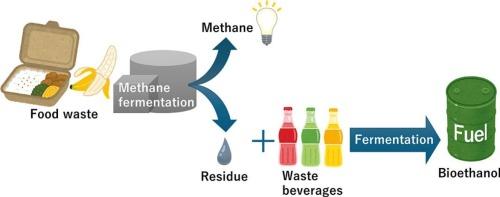Ethanol production from non-sterile methane fermentation residues for waste-to-biofuel conversion
Q1 Environmental Science
引用次数: 0
Abstract
Effective valorization of food waste is essential for sustainable resource management. Methane fermentation residues, a byproduct of biogas production from food waste, are typically used as liquid fertilizer. However, their full potential as bioresource substrates remains underexplored. This study investigated the feasibility of producing bioethanol from non-sterile methane fermentation residues mixed with beverage waste under realistic, low-input conditions. Four sucrose-fermenting yeast strains were evaluated for ethanol production in a non-sterile medium composed of residue and deteriorated beverage (1:1, v/v). Ethanol was detected only under the non-sterile condition, not in filter-sterilized controls, suggesting that native microbial populations did not inhibit—and may have enhanced—fermentation. Saccharomyces pastorianus NBRC 11024T achieved the highest ethanol yield (27.4 g/L), reaching 89.4 % of the theoretical maximum within 48 h. Fermentation efficiency declined when the residue ratio exceeded 70 %, indicating possible inhibition due to nitrogen or volatile fatty acid accumulation. 16S rRNA amplicon sequencing revealed a marked shift in microbial community structure, with Leuconostoc species dominating at later stages. These findings suggest that methane fermentation residues can be used as functional co-substrates for ethanol production and may actively contribute to favorable fermentation conditions. In addition, commercially available beverages were shown to be a suitable model for waste beverages and provided practical insights into real-world applications. This approach offers a scalable, decentralized strategy for low-cost ethanol production and contributes to the development of circular bioresource systems.

利用非无菌甲烷发酵残留物生产乙醇,用于废物转化为生物燃料
有效评估食物浪费对可持续资源管理至关重要。甲烷发酵残留物是食物垃圾产生沼气的副产品,通常用作液体肥料。然而,它们作为生物资源基质的全部潜力仍未得到充分开发。本研究探讨了在现实的低投入条件下,利用非无菌甲烷发酵残留物与饮料废弃物混合生产生物乙醇的可行性。研究了4株蔗糖发酵酵母菌在由残渣和变质饮料(1:1,v/v)组成的非无菌培养基中生产乙醇的能力。仅在非无菌条件下检测到乙醇,而在过滤灭菌的对照中没有检测到乙醇,这表明本地微生物种群没有抑制发酵,甚至可能增强了发酵。酵母NBRC 11024T的乙醇产率最高,为27.4 g/L,在48h内达到理论最大值的89.4%。当残渣比超过70%时,发酵效率下降,可能是氮或挥发性脂肪酸积累抑制了发酵。16S rRNA扩增子测序显示微生物群落结构发生明显变化,后期以Leuconostoc物种为主。这些发现表明,甲烷发酵残留物可以作为乙醇生产的功能性共底物,并可能积极促进有利的发酵条件。此外,市售饮料被证明是处理废饮料的合适模型,并为实际应用提供了实际见解。这种方法为低成本乙醇生产提供了一种可扩展的、分散的战略,并有助于循环生物资源系统的发展。
本文章由计算机程序翻译,如有差异,请以英文原文为准。
求助全文
约1分钟内获得全文
求助全文
来源期刊

Bioresource Technology Reports
Environmental Science-Environmental Engineering
CiteScore
7.20
自引率
0.00%
发文量
390
审稿时长
28 days
 求助内容:
求助内容: 应助结果提醒方式:
应助结果提醒方式:


